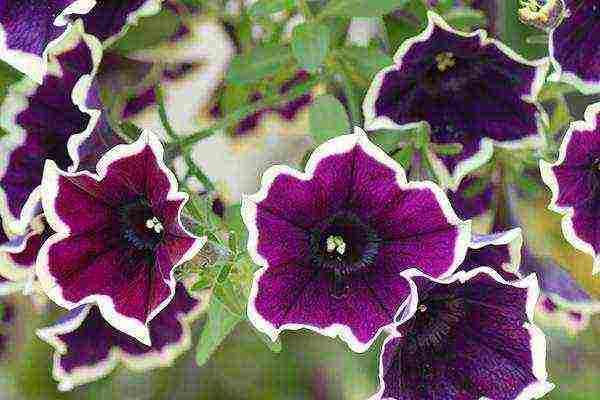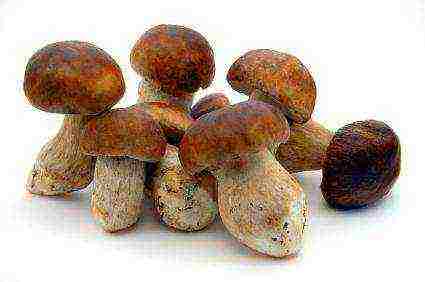Content
- 1 Plant advantages
- 2 Seed selection
- 3 Soil composition and sowing containers
- 4 Rules for growing seedlings of petunias from seeds
- 5 Features of caring for flower seedlings
- 6 How to grow petunia from seeds at home for seedlings
- 7 When to sow petunias for seedlings?
- 8 How to solve difficulties when growing from seeds.
- 9 How to plant petunia in peat tablets to get 100% seed germination
- 10 How to get petunia seeds at home?
- 11 Planting petunias with seeds
- 12 How to properly grow petunia from seeds?
- 13 Why don't petunias from seeds bloom?
Petunia has long conquered floriculture enthusiasts and has become No. 1 among the leaders in the number of varieties, in the number of grown specimens, in terms of use in various compositions. It takes root well in flower beds, ridges, alpine slides, in pots and containers. And everywhere it feels great, adding bright, sunny colors to our world. Consider what kind of petunia is needed for growing from seeds and when to plant seedlings.
Plant advantages
Why did the plant become so popular in a fairly short time? After all, growing petunias from seeds is not an easy task. But flower growers cope with these problems because they know what the result will be: a chic, bright bush, covered with simple or double flowers, with a wonderful aroma. It's worth the work!

And the qualities that distinguish it from other colors are many:
- cold resistance, which is especially appreciated by residents of the northern regions,
- unpretentiousness and ease of growing,
- you can grow yourself, and not buy seedlings in flower centers,
- has many shapes and shades,
- many varieties are fragrant,
- good in both single and group landings,
- blooms throughout the summer.
In addition, hybrids (F1) appeared on sale, completely unique in their survival rate, abundant flowering, and a variety of forms. There are plenty to choose from and create a unique floral arrangement.
Seed selection
Breeders offer a huge selection of seeds. This is great, but the choice must be approached consciously. Remember that hybrids for the next year will not give you a flower waterfall, such seeds are used once. Look at the expiration date on the package, because the seeds "hatch" for a long time, and it will be unpleasant if they do not sprout at all.
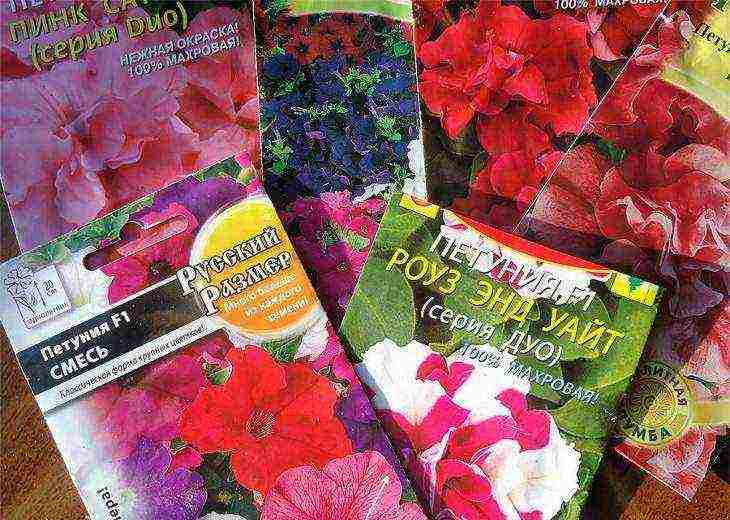
Choose seeds based on your needs. What compositions do you want to create, what dreams and fantasies do you want to realize? Maybe you need cascading or ampelous petunias. Maybe double forms or simple ones are interesting, but so that the scent surrounds your home.
Be sure to read the characteristics on the back of the bag, and the shape of the plant itself will become clear, how much space it will take, what diameter the flower will be. Now they sell all the seeds, mostly pelleted, wrapped in a nutrient film. There are not many of them in the package. And they are usually expensive. But do not spare the money, because you need a good result. A beautiful, lush petunia originates from a small seed.
Soil composition and sowing containers
It is best to use containers with transparent lids (possibly heated), in which plastic or peat jars, peat tablets, egg trays are placed. There are universal containers on sale: with jars inside, with a lid, and heated. All the conditions so that you can grow petunias from seeds at home.
Tip: you can take different containers for planting, but remember that the seeds are very small, therefore, at first, the container will need to be covered with glass or transparent material on top to retain moisture.
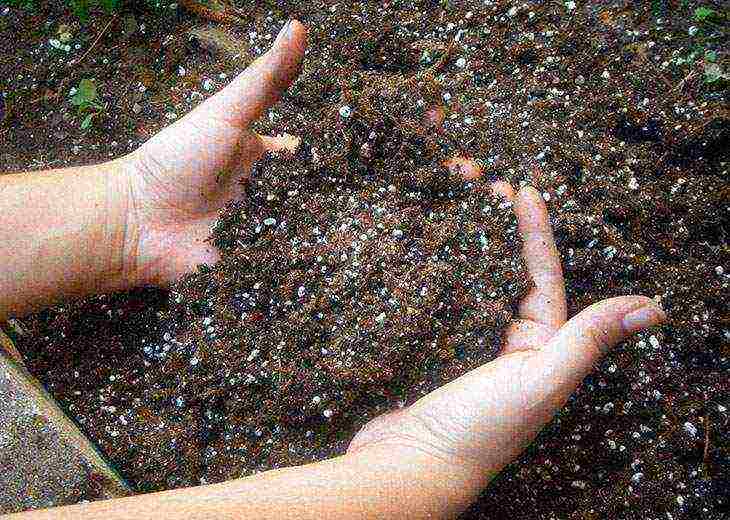
The composition of the soil consists of leafy soil, peat, fine sand and humus. That is, the mixture is light and nutritious at the same time. The mixture should be sieved and steamed for 1 hour (against diseases and weeds).A layer of fine gravel can be poured into the bottom of the container, or a hole can be made (which is best) so that the root system can consume the required amount of water. When grown from seeds at home, petunia is painful to lack of moisture, so the soil should not dry out.
Fill each container with soil, not reaching 1 cm. To the top (for watering), slightly compact it, otherwise the seed may "fall" into the soil. In the center of the jar, make a small indentation for planting.
Tip: It is advisable that the container is under one plant, and it can be removed without damaging the roots when you plant it in a permanent place.
Rules for growing seedlings of petunias from seeds
The main question of interest to flower growers: "When to plant petunias from seeds, followed by cultivation in the open field?" After all, large seedlings will hardly take root, and small ones will not have time to please us with flowers throughout the summer.
Petunias at home should be sown no earlier than mid-March, when daylight hours will be longer, and the seedlings will turn out to be medium in size. You can plant seeds in the last days of February, but in this case additional lighting will be required. Germination of seeds requires a high room temperature - +25 degrees.
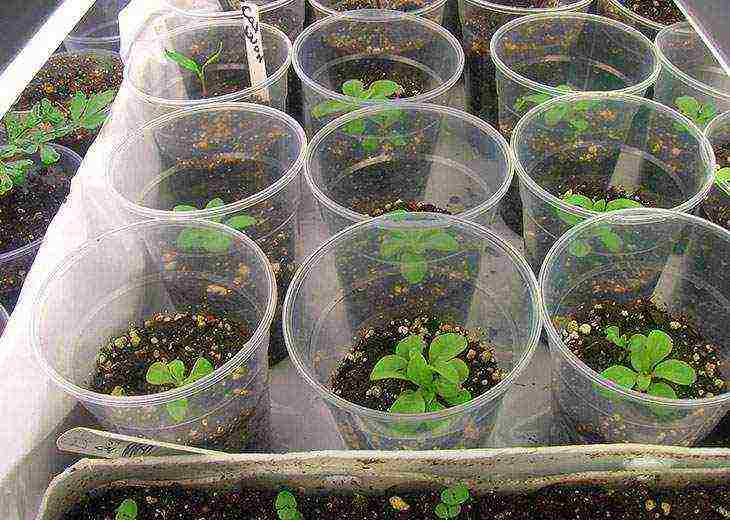
How to properly grow petunia seedlings? Let's consider several ways:
- The seeds are mixed with sand, evenly scattered over the surface of the earthen mixture, sprayed with a spray bottle and covered with captivity.
- If the seeds are pelleted (covered with a nutritious shell), then each seed can be placed separately in a peat tablet, making a small depression in it and covering it with a film.
- Compact the soil a little, cover the top with a small layer of 1-1.5 cm of snow. Spread the seeds evenly on the snow. It will melt and the seeds will be on the surface of the soil. Cover the container with glass, place in a warm, well-lit place. You can put a table lamp next to it.
- Place the seed in each individual peat pot and cover with foil. Place the pots in a tray. So it is more convenient for you to monitor the seedlings, and excess moisture will collect at the bottom of the pallet.
Tip: The seeds of this flower culture are small in size and do not need to be sprinkled with earth. But they need moisture: constant spraying is necessary as well as regular ventilation.
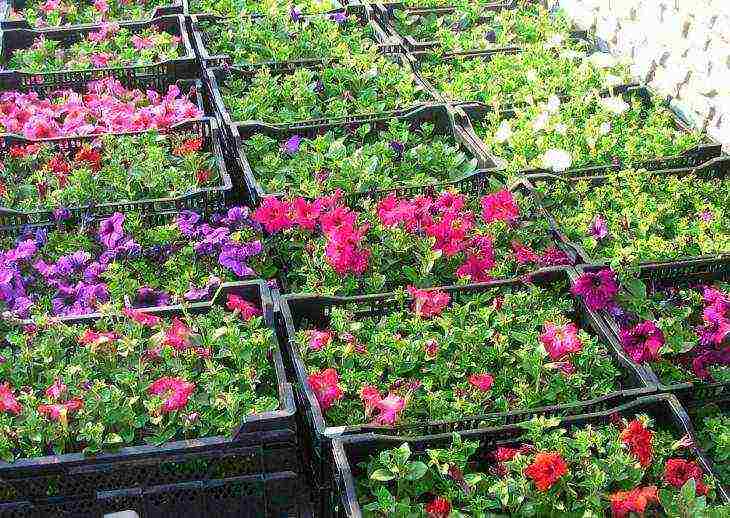
It can be concluded that growing petunia from seeds is troublesome, but the result will exceed all your expectations!
Features of caring for flower seedlings
If you do not have specific knowledge of how to grow petunia seedlings, then we will tell you about it in stages:
- Seedlings will sprout in a week. Seedlings are weak and small, all the forces of which are spent on the development of the root system. If the plants are densely growing in the container, carefully thin them out. Otherwise, the seedlings will stretch out and turn out to be frail and weak.

- In addition, it is necessary to periodically ventilate the seedlings. Remove the film or glass, remove the condensation and leave the seedlings for an hour "in the fresh air." Also remove moisture from the seedlings so that water droplets do not appear on the leaves. If the air stagnates in a humid environment, then mold, fungi and still weak seedlings can get sick on the surface of the earth. You need to ventilate every day.
- Continue watering, but very gently. Watering should be drip or can be sprayed from above using the same spray bottle. Do not pour water over a container or pot. Neither excess nor lack of moisture is needed here.
- Seedlings grown in a container should be dived into pots. Gently loosen the soil with a toothpick or fork, pinch the long roots and transfer to a separate container. With a noticeable stretching of the seedlings, it is better to place it in a cool place for a while (veranda, balcony).
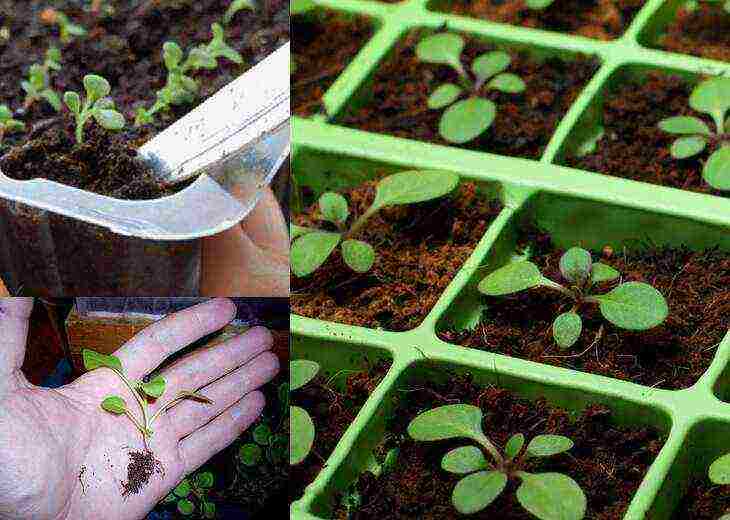
- If containers or pallets with seedlings are located on the south or west windowsill, then there should be no problems with lighting and the seedlings will not be pulled out.But the north and east sides require mandatory lighting. Now there are special lamps on sale, but you can do it yourself. For example, place a sheet of foil (or mirrored sheet) so that the sun's rays are reflected and re-incident on the plants.
- Grown hybrids, with strong shoot growth, need to be pinched. The shoot needs to be pinched over 4-5 sheets. The plant will begin to bush well, which is what is needed for abundant flowering and large volume.
- Seedlings can and should be hardened, especially if you survive in the northern regions. We harden it gradually: first, we take it out into a room where the temperature is 10 degrees, for 10-15 minutes and every day we increase the time. Subsequently, the plant will be resistant to temperature extremes in the open field.
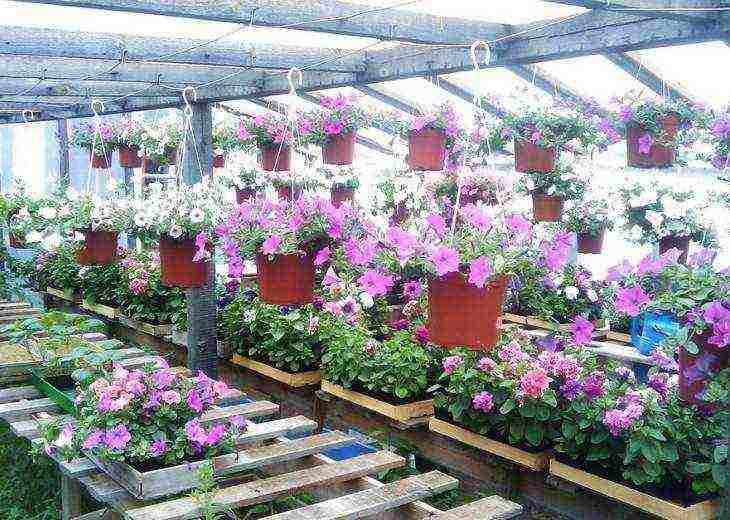
At home, growing petunias on your own from seeds is not so difficult, because it is constantly under supervision, and if you correctly follow all the rules of care, then the seedlings will turn out to be strong and strong.
Tip: root picking should be carried out when the plant has already formed and has 4-5 leaves, i.e. when the plant is strong enough for such a procedure. Plants in peat tablets are not dived.
The front of the work is large, but now there should be no questions about how to grow petunia, so you are guaranteed success in the form of bright, flower beds.
Petunia is a beautiful and vibrant annual flower. One of the most popular flower beds in recent years. There are varieties of petunias with creeping and hanging shoots. They are grown in flower beds, in pots, boxes on the windowsill, hanging baskets.
Loved by many gardeners - gardeners for its long flowering (from June to October) and bright colors. The petunias are white to purple in color. New varieties delight every year with their delights. You can now grow rose-like terry petunias with white stripes and a white border.
It is quite simple to grow petunia from seeds at home through seedlings, but not everyone succeeds. But if you learn all the subtleties and follow them, then you will only need to plant 1 bag of seeds and your whole garden will be fragrant. The seeds of petunia flowers are small, so many novice gardeners do not understand what to do with them.
How to grow petunia from seeds at home for seedlings
Pour soil for flowers into any not very deep container. There are different manufacturers of potting mixes, you can choose any. You can make your own potting soil mix for seedlings. To do this, take 2 parts of well-rotted humus, sod or leafy soil, high-moor, well-decomposed peat and 1 part of sand. If the soil is acidic, add lime to it. Everything must be mixed well and sieved through a sieve. First through the large one, then through the smaller one.
Fill the lower part of the seedling box with coarse screenings, a layer of fine or crushed expanded clay can be poured onto the bottom, and the upper third with small ones. Fill a suitable container with damp soil, scatter seeds over the surface, and spray with water from a spray bottle.
So, having poured the earth, apply it from above with your palm, lightly tamping it, pour it with water so that the soil becomes moist. Brush the surface with your palm again and sprinkle flower seeds on top.
 If you are planting a seed in a granule, stick a match next to each seed to know where the sprout is expected. Petunias sprout for a very long time - two weeks. Do NOT sprinkle on top. But be sure to cover with glass, plastic wrap or cut the stationery transparent corner into two halves and cover with it. It is necessary to achieve a greenhouse effect. When planting seeds in granules, you can plant flowers in peat tablets or mini - greenhouse. This makes growing from seeds more convenient and efficient.
If you are planting a seed in a granule, stick a match next to each seed to know where the sprout is expected. Petunias sprout for a very long time - two weeks. Do NOT sprinkle on top. But be sure to cover with glass, plastic wrap or cut the stationery transparent corner into two halves and cover with it. It is necessary to achieve a greenhouse effect. When planting seeds in granules, you can plant flowers in peat tablets or mini - greenhouse. This makes growing from seeds more convenient and efficient.
Place the planting in a warm, sunny place.Make sure that the soil is always moist, wash off the condensation on the glass, otherwise the sprouts that appear may rot. As soon as the first green shoots appear, the glass must be removed.
Here, it is so easy to grow petunia from seeds. Not all seeds sprout, but a lot. Therefore, you will distribute the seedlings of petunias to all your friends.
When to sow petunias for seedlings?
Planting timing depends primarily on your desire when you want the flowers to bloom. This is a plant with a long vegetative development from planting to flowering. If you want early flowering, then sow petunias for seedlings in mid - late February. The latest planting dates are mid-April. If you are late with planting, then save the seeds for next year or accept the fact that the flowering will be later.
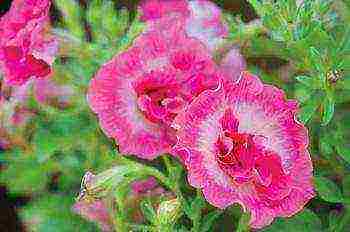
The most important thing for growing petunias from seeds
- The presence of non-woven material - to maintain the necessary moisture, the soil should not dry out.
- Adequate lighting.
- Watering should be moderate. Excessive watering leads to decay of the plant roots.
- The temperature regime is better to keep it from 24 to 26 degrees. When petunia shoots appear, the temperature should be reduced to 18-20 degrees. Then there are no special difficulties in growing petunias from seeds.
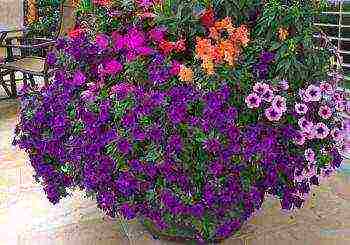
How to solve difficulties when growing from seeds.
I repeat that the main problem is that the seeds of petunia are very, very small and not all of them sprout. For convenience, you can use seeds in granules. It is more convenient to plant them, but there are only 10 seeds in a bag. This is very little for creating a flower garden in the country, and besides, it turns out to be very expensive. Elite petunia seeds are sold in granules - terry. They are very showy, almost like roses. Their flowering time is shorter than that of ordinary petunias.
How to plant petunia in peat tablets to get 100% seed germination
To main
Rate the quality of the article. We want to be better for you:
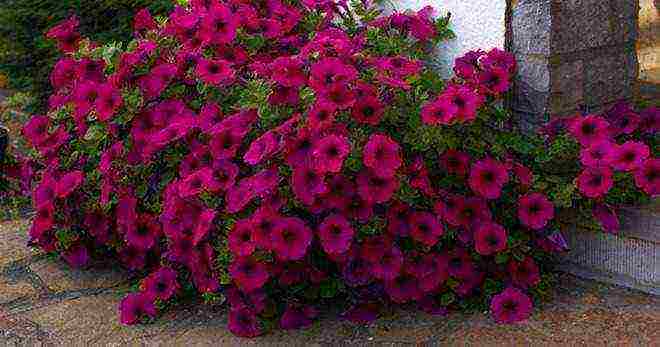
Most gardeners are interested in how to grow petunia from seeds, because the cost of planting material is high and arranging a large bright flower bed will require significant financial costs. It is better to learn how to independently cultivate seedlings, the effort is worth it - the flower garden will shine with buds with elegant "skirts" of various colors.
How to get petunia seeds at home?
For the first time, the seeds can be bought at the store and grown seedlings. But then, when breeding flowers, the question still arises - how to collect petunia seeds at home. There are some tips:
- grains for future flowers are taken from standing and wilted plants, which must be noticed even at the time of their flowering;
- the seed ripening cycle is 2-3 months, when collecting them, it is important not to rush;
- it is necessary to store the seeds in a dry place with room temperature, wrapped in paper or foil, they retain their germination for several years;
- many varieties are hybrids and do not produce secondary offspring. You can get your own seeds from simple varieties of petunias.
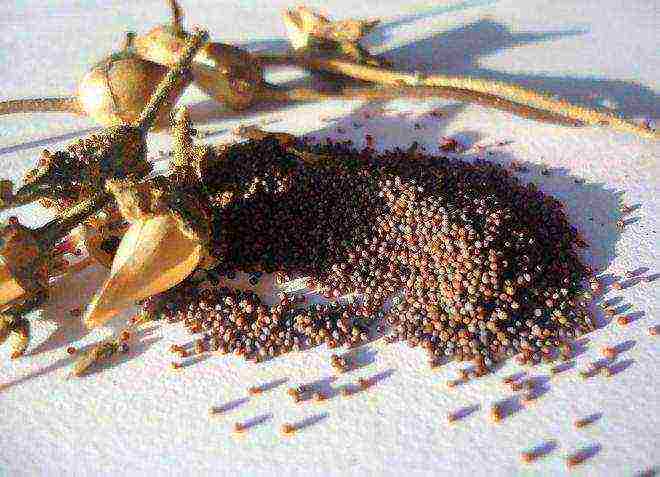
Planting petunias with seeds
In order for the germination process to take place as soon as possible, before planting petunia with seeds, they must be processed. To do this, it is necessary to carry out the scarification procedure - the grains are placed in a pot with moistened sand, wrapped in foil. Then the seeds are kept in the refrigerator for 2 months. From time to time, the pot must be taken out and the sand watered.
Sowing seeds of petunias - timing
To plant petunia seeds correctly, it is important to choose the correct sowing time:
- Petunia can be rooted very early - in February. But the lack of light leads to the fact that the sprouts become elongated, weak, unable to cope with diseases. Such landings need to be additionally illuminated with lamps in order to increase their daylight hours (it should be about 16 hours).
- For normal sowing, seeds are planted from mid to late March. At this time, the sunny day is already long in order to provide the sprouts with the necessary amount of light.In this case, it is better to place the container with seeds on the south, east or west window.
- It usually takes 3-3.5 months from planting in the ground to flowering culture.
How to properly grow petunia from seeds?
Before growing petunia from seeds at home, prepare wide, not very deep containers - cassettes, boxes, cups. In any container, you need to make more holes so that water does not stagnate, otherwise the seedlings will die from a fungal disease called "black leg". Alternatively, you can plant petunia seeds in a pot, but it is more convenient to take a plastic rectangular transparent cake box with a lid. There are some features of how to grow petunia from seeds:
- Its grains are small, so they are laid out on the surface of a moistened substrate with a toothpick, without then falling asleep with earth. Flower seeds need light to germinate. Therefore, the sowing is carried out superficial, it is impossible to sprinkle the grains with earth, otherwise they will not be able to break through. For better contact with the soil, the seeds can be lightly pressed with a toothpick.
- Then the container is covered with a lid, foil or glass, placed in a warm place.
- Growing petunia seedlings is carried out at + 20-25 ° C.
- To prevent condensation from dripping onto the sprouts, you need to systematically ventilate the container and wipe off excess moisture from its surfaces.
- When the first leaf appears at the seedlings, the plantings begin to air.
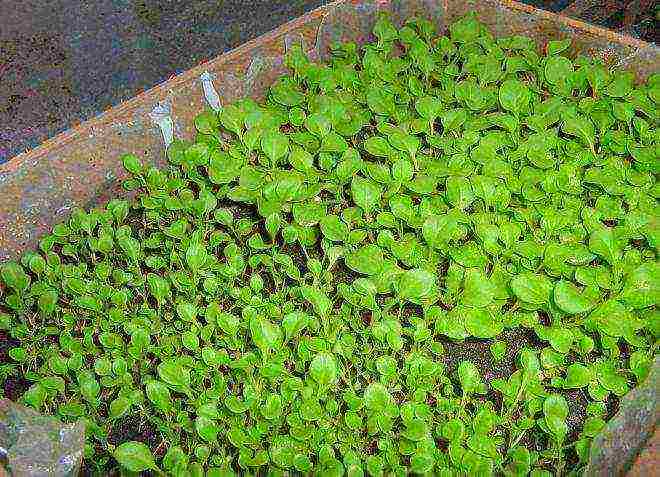
How to grow petunia from seeds - soil
For decorative petunias, when grown from seeds, you need a loose, fertile and moisture-absorbing soil. Plants like purchased peat-based flowering soil. You can also make your own mixture. To do this, mix the same parts of humus, sod land, peat and sand. Before planting, it is better to sift the substrate and disinfect it in a double boiler or colander for an hour. This will protect petunia sprouts from diseases and weeds.
Petunia from seeds at home - watering
For garden petunias when grown from seeds at home, it is important to properly water the seedlings. The sprouts need to be checked so that the soil is not very wet, but also not dry. To do this, seedlings are sprayed daily at least a couple of times a day. It is better to water it in a tray or gently right under the very roots. Periodically, it is recommended to irrigate seedlings with a weak solution of potassium permanganate so that they do not get sick with a black leg.
The quality of watering is also important, since in order to successfully grow petunias from seeds, you need a soft liquid that does not contain chlorine. To do this, it is recommended to stand tap water for at least a day; before watering, add a little lemon juice to it. The temperature of the liquid and the soil must be the same. Watering is carried out in the evening, since at night the growth rate of shoots is higher.
How to grow petunia from seeds - top dressing?
To grow petunia from seeds at home, it will take 2-3 months until it gets warmer outside. To obtain strong and healthy seedlings, when the seedlings grow up a little, they begin to feed. The flower is very responsive to fertilization. Knowing how to plant petunia with seeds, and giving the plant plenty of nutrients, the culture can delight with bright buds until the very cold. First, top dressing is applied from 5 to 14 days - when the first shoots appeared. It should be based on calcium (prevents stretching) and nitrogen (stimulates the development of lateral shoots).
The next make-up is applied after a couple of weeks after picking every two weeks. At first, only fertilizing foliage is used for seedlings, alternating growth biostimulants and mineral complex fertilizers containing nitrogen, for example, Agricola. In the future, for budding, it is necessary to carry out root feeding with compositions based on phosphorus and potassium. It is better to use liquid forms that are diluted with water.

How long does it take for petunia seeds to germinate?
When asked how much petunia seeds will sprout, experienced gardeners give an unambiguous answer - after a week or two. At the same time, the lid or glass is not immediately removed, the plant is first taught to fresh air - it is opened for a couple of hours a day. After two days, the lid can be removed completely. The temperature of the seedlings is reduced - during the day it should not exceed + 20 ° C, at night - + 16 ° C (this is an important point of growing).
When 4-6 leaves appear on the seedlings, they are dived - each copy is transplanted into a separate transparent pot. In this case, the seedling is deepened to the first leaves in order to reduce the likelihood of rotting. Placing in larger containers will allow plants to grow roots for the first month. When the soil in the cup is tightly intertwined with underground processes, the shoots are transplanted into pots with a volume of up to 2 liters, where they grow before planting in the garden.
From the end of April to the beginning of May (after spring frosts), grown and strengthened seedlings are transferred to open ground. Planting is carried out in the evening or on a cloudy day, having soaked the roots of the seedlings with water in advance. The distance in the flower bed is 20-25 cm, after moving the flowers are watered, the soil around the seedling is mulched with peat, humus to protect it from the cold and preserve moisture.
Why petunias from seeds don't bloom?
Before growing petunia from seeds, it is important to study the peculiarities of plant cultivation. If the plant does not bloom for a long time, you need to pay attention to the following main points:
- To grow petunia from seeds at home, you need to plant seedlings in the garden in a well-lit place - the plant likes light and warmth.
- The beauty needs nutritious feeding. It is recommended to alternate watering with fertilizers: nitrogen stimulates growth, is used at the beginning of the growth of the bush; potassium and phosphorus are needed for bud setting. The optimal feeding scheme: watering, applying organic matter or mineral fertilizers, again moistening, spraying with top dressing on the leaves.
- Soil moisture. Adult plants need, though not frequent, but abundant watering. And young seedlings cannot be moistened a lot - they may die.
- Dead petals must be removed along with the pedicels, this will provoke a new wave of budding. It is better to do this every day, otherwise the seed pods will begin to tie, and the flower will give all its strength to the formation of seeds.
- Pinching is necessary for young bushes, the top is removed from them, leaving 3-4 leaves. This stimulates the growth of new shoots and buds.
- In the lower part of the plant, it is also necessary to systematically remove wilted leaves. Some pest can start in the rotting tops.
Petunia is an absolute favorite among the annuals. In terms of popularity, distribution, and abundant flowering, this plant outshines any other competitors. Seedlings of petunias from spring to autumn flood store shelves. Growing petunias from seeds on your own is not an easy task. But with some diligence and attention, you can create your own collection of petunias yourself.
Growing seedlings of petunias from seeds
Content:
- Petunia seeds: self-collection and purchase
- Sowing petunias for seedlings
- Soil and containers for sowing petunias
- Sowing petunia seeds
- Conditions for seed germination
- Growing plants
- Diving seedlings and caring for young plants
- Hardening of petunia seedlings
- Planting petunia seedlings in soil and containers
- Growing petunias by sowing in open ground
- Alternative breeding methods for petunias
Garden petunias (Petunia x hybrida or Petunia hybrida) are some of the most famous members of the Solanaceae family. With a height of 10 to 100 cm, this herbaceous annual with well-branching, densely leafy, creeping or straight shoots allows you to choose larger or more compact varieties. Oval soft leaves with a solid edge, the shape and presence of a pointed tip, which may differ depending on the variety, sit on the shoots alternately.The beautiful edge emphasizes the light tone of the leaves.
The huge funnel-shaped gramophone flowers of petunias with their correctness or irregularity and various colors are the main decoration of the plant. They create whole blooming clouds and cascades, but the beauty of each flower is mesmerizing. Blooming in early summer and not slowing down until the frost arrives, petunia offers a considerable choice of colors, flower sizes, variations of multicolored colors and ruffled edges, varying degrees of terry and even the shape of the corolla.
The variety of petunias is so great that it is not easy even for experienced flower growers to understand the groups, varieties, classes and varieties. But in terms of cultivation techniques, all petunias are similar. In the matter of reproduction, all petunias practically do not differ from each other. And petunias grandiflora, and multiflora, and nana, and individual groups of petunias, and even fashionable novelties multiply mainly by seeds - seedling.
Petunia seeds: self-collection and purchase
After flowering (defloration), petunias are tied with two-nested capsules-cones of fruits a little more than a centimeter long, which turn golden brown as they ripen. It is by color that the timing of seed collection is determined, which on average is 4-8 weeks after petunias flowering. You should not rush to remove the seeds from the fruit pods: their full ripening will occur only after 3 or even 4 months. Petunia fruits are laid out in a dark, ventilated place with standard room temperatures. After 4 months, the seeds can be removed, sorted, marked and stored in paper bags protected from cold, heat, light and high humidity.
To get petunia seeds on your own, you need to leave some of the wilting flowers on the plant. It is preferable to leave the lower buds, which are among the first to bloom. When collecting petunia seeds, it is better to be prepared for the fact that the offspring will not retain the characteristics of the mother variety and will surprise with its variety of qualities. In order to collect seeds yourself, you also need to pay attention to three important nuances:
- To collect your seeds, you will have to select only varieties: sterile hybrids, terry forms of seeds do not form, since as a result of selection, the ovaries of such petunias have transformed into petals.
- Petunias are cross-pollinated plants, self-pollination occurs only in isolated cases.
- Pollination of non-double plants with pollen of varietal double petunias allows you to get some of the seeds with double flowers, but still the number of plants that have retained their characteristics will not exceed 30%. It is for this reason that it is recommended to buy seeds for terry varieties.
Inside the capsule are surprisingly small seeds that make the job of sowing the plants very difficult. The diameter of the dark brown petunia seeds merging with the soil is slightly more than half a millimeter. Due to their tiny size, one gram of seeds contains up to 5-10 thousand potential plants (in large-flowered varieties, the seeds are slightly larger than in multi-flowered varieties). About a hundred seeds can be collected from one fruit, therefore petunias are rightly called one of the most prolific annuals.
The number of petunia varieties is measured in thousands. Choosing professional or "regular" petunia seeds is not an easy task:
- First of all, you need to focus on decorative characteristics - features of flowering, color, plant height, foliage density, shape and length of shoots, the recommended use of a separate variety. Ampel varieties are used only for hanging baskets and cascades in boxes, in all other cases, due to dense tillering and good branching, bush varieties are preferred.
- When choosing petunia seeds, it should be borne in mind that these plants have an average growing season of about 70 days.Small-flowered petunias bloom at typical times, large-flowered petunias bloom at least three weeks later.
- On sale there are both individual varieties and variety series, and mixtures of varieties. The latter for petunias always carry the risk of not getting exactly the result that is expected. Therefore, it is better to purchase individual varieties and sow them, creating your own collection, rather than buying a variety mixture with different shades.
- Equally important is the choice of the manufacturer itself, and specialized stores or garden centers, and not spontaneous points of sale. Proven on other letniki, proven to be reliable firms for petunias are preferable to experimenting with new suppliers. Pay attention to the completeness of information about the manufacturer itself, the quality of the description of the plant and the recommended agricultural technology, the availability of all information about the shelf life and the batch of seeds.
- Petunias are common, but by no means budgetary annuals; too low a price for seeds is associated with a high risk of buying low-quality planting material.
- In petunias, ordinary seeds are considered more reliable, although pelleted ones are more convenient to use (but they are more sensitive to the accuracy of sowing - timing - and lighting parameters).
Petunia seeds remain viable for a long time, they can be purchased for future use. Within three to four years, seed germination is practically not lost, so buying the freshest seeds is not at all necessary.
Petunia seed shoots
Petunia is not the easiest culture. Small seeds, fragile and sensitive seedlings require care when growing seedlings. Still, the beauty of the summer is worth the effort.
Soil and containers for sowing petunias
To grow petunias from seeds at home, there is no need to select special containers. Ordinary seed boxes and low containers or bowls are suitable for this summer. Since petunia is not afraid of transplanting, they do not use individual cassettes or peat tablets for it, but large common containers. The optimal soil height for petunias is about 6-7 cm, too low containers will not work for this summer, but it is better to avoid deep ones. The containers in which the plants were previously grown must be additionally prepared and disinfected.
For diving seedlings of petunias, small individual plastic and peat pots or cassettes are used. A diameter of 6 to 8 cm is sufficient for the normal development of young annuals.
For seedlings of petunias and sowing seeds, any high-quality soil mixture for growing seedlings is suitable. Both independently mixed and purchased substrates, if they are loose, nutritious, capable of retaining moisture, but not prone to compaction, do not have a strong acidic or lime reaction, are perfect. The standard is pH 5.5.
For petunias, a universal substrate is often used, consisting of equal parts of humus, sod, leafy soil and peat with a halved proportion of sand. Any soil before sowing petunia seeds is best disinfected with a solution of fungicides or calcined a few days before sowing and sifted at least for the top layer. For sowing and diving petunias, use the same substrate.
Sowing petunia seeds
Early sowing dates are preferred for petunias. If there is no opportunity to organize supplementary lighting, then sowing is carried out in March. For regions with severe winters, the middle lane, sowing is preferable in the second half of March, but most often, to obtain an earlier flowering, petunias are sown in the first half of March or even in February (the third decade allows sowing in good years without supplementary lighting). Sowing of petunias is not carried out later in March, since the plants will not have time to reveal all their beauty and their flowering will be very late. There are many nuances in choosing the timing of sowing petunia seeds:
- Petunias sown in the second and third decades of March bloom by June, when sown in January and February, the dates are respectively shifted to April-May, but such cultivation requires special conditions.
- There is a variation in the recommended sowing dates and for individual varieties of petunias. Late flowering large-flowered petunias are best sown later, in March, multiflora can be sown earlier, in February, and ampelous petunias for the largest mass of long shoots are better sown with supplementary lighting in January.
- At any time of sowing, you should be ready, if necessary, to compensate for the lack of lighting: photophilous petunias in an unsuccessful spring without additional lighting can be completely lost (due to cloudy weather).
When purchasing seeds and planning sowing, it is always better to carry out calculations with a margin, increasing the number of seeds by 30-50%, especially if the sowing is carried out at an earlier date. Due to poor lighting, there is always a risk that only half of the seeds will sprout, although under good circumstances the germination rate of petunias is from 80 to 100%.
Small seeds are rightly called the main difficulty of self-growing petunia seedlings. They are so inconvenient to work that for the first experience of growing this summer, we can recommend the choice of tape, dragee or inlaid seeds, which are much easier to sow. But working with ordinary "simple" seeds can be simplified:
- by mixing petunia seeds with sand (you need to use fine, dry, light sand, and not screenings);
- sowing on a layer of sand or snow, on which even the smallest seeds are clearly visible;
- use a toothpick for "piecewise" unfolding (this is the most time consuming option).
To sow petunias for seedlings, you must:
- Fill the selected containers up to half or a third of the height with coarse screenings or whole substrates and tamp them lightly. If the containers are very deep or the soil is fine-grained, then it is better to lay drainage at the bottom of the container.
- Top up the sifted substrate without tamping. Since the shelter from the crops is removed late, it is necessary to leave enough space in the containers for plant growth: from the top of the substrate to the edge of the containers for sowing petunias, a distance of 2 to 3 cm should remain.The layer of sifted soil should be at least 1 cm (so the seeds will lie more evenly, and the plants will develop equally).
- Carefully level the soil surface and thoroughly moisten it with a fine spray. For petunias, it is sometimes recommended to water abundantly a day before sowing to evenly distribute moisture and "saturate" the soil, but the classic version can also be used. Cover the soil with sand or snow to facilitate planting if you have not taken additional measures.
- Scatter petunia seeds as rarely as possible, trying to sow evenly over the entire area of the container.
- Spray the seeds from the top with a spray bottle, taking care that strong jets do not wash out individual seeds. For the first spraying, you can use a growth stimulant solution. When sowing on snow, spraying is not carried out.
- Cover the container with glass or foil, without covering the seeds on top with even a thin layer of sand.
The first pick of petunia seedlings
Petunia loves stable heat. For seed germination, it is desirable to maintain the temperature at 20-23 degrees Celsius. Cooler conditions will allow only old varieties or "wild" petunias to emerge, the seeds of which are harvested on their own. All modern varieties are temperature sensitive during the germination stage.
If the lighting is not bright enough, the weather is cloudy, then phytolamps for supplementary lighting should be placed above the containers. The film or glass is lifted daily for ventilation.
Maintaining moisture is not an easy task. Before emergence, it is advisable to carry out light spraying daily in order to maintain a stable light soil moisture.A light fungicide can be added to the water for spraying seeds (for example, using a weak solution of potassium permanganate).
Petunia shoots appear (on average) 5-7 days after sowing. Petunias germinate within 2 weeks, you should not expect sprouting longer than this period: if there is no result, you need to adjust the agricultural technique and re-sowing. This summer plant is characterized by friendly shoots, usually shoots appear evenly and within a short period.
Growing plants
Petunia seedlings are very tiny, fragile, capricious and sensitive to the slightest deviations in growing conditions or moisture levels. Petunias develop slowly. Temperatures and bright lighting for small petunias are kept the same. The optimal duration of daylight hours for young seedlings is 11-12 hours.
The film or glass from the containers with petunias can be removed only after the first sheet appears. Daily ventilation is carried out 2-3 times a day, preventing the accumulation of condensation and maintaining a healthy environment for plant development.
The greatest danger during the growing stage is high humidity. Petunias are one of the most prone to black-footed diseases, therefore, waterlogging and generally inaccurate watering are extremely dangerous. But drying out of the soil can destroy all seedlings. Gentle spraying of crops is carried out daily to create stable, slightly damp conditions.
Small shoots tend to bend. The containers need to be rotated in relation to the light source several times a day so that they develop evenly (there is no need to rotate with top supplementary lighting).
Excess moisture, lack of comfortable temperatures or lighting can lead to the spread of diseases. If the seedlings show signs of the development of a black leg, the plants begin to hurt, then an emergency dive is carried out. To reduce moisture, the seedlings must be carefully sprinkled with a layer of dry sand and immediately proceed to transfer them to individual containers.
Diving seedlings and caring for young plants
In petunias, diving is carried out as soon as a pair of true leaves is formed on the plants. It is better not to delay the process of planting seedlings, but an earlier transplant is an exceptional option only for diseased plants. Plant transplantation is well tolerated. They are seated one at a time. After diving, the plants are watered carefully and set for a day or two in places with diffused lighting or shaded with paper to better restore them in a new place.
Bright lighting for petunias is important at any stage of their development. Supplementary lighting on cloudy days is carried out after a dive only for a weakened one that has begun to stretch out or clearly signal a lack of lighting for seedlings. The temperature can be left in the room range, but it is better to gradually start lowering it to 18-20, and then 16-18 degrees with somewhat cooler conditions at night. Both the frequency and the airing time are slowly increased even before quenching.
Top dressing for seedlings is very dangerous, they can be started only after diving - after about 1-1.5 weeks. At the stage of growing seedlings of petunias, they are carried out to obtain strong branched plants and abundant flowering. Fertilize the water for irrigation every week using half the manufacturer's standard dose. At the seedling stage, foliar and root dressings can be alternated. With slow growth, nitrogen fertilization is carried out, but petunias still prefer complex and organic fertilizers.
The main attention should be paid to high-quality and moderate watering. Waterlogging even on grown petunias is very dangerous, it can provoke the development of rot and death of plants. Watering is carried out with a small amount of water, but often checking the degree of soil drying.These neat procedures are essential for petunias to keep drips out of the greens and shoots. When it grows enough leaf mass and releases the first buds, the humidity for it can be slightly lowered.
In caring for petunia seedlings, it is better not to forget about two more procedures:
- Pinching the shoots allows you to get dense, branched and more compact crowns in bush varieties of petunias.
- Loosening the soil after watering will maintain optimal air and water permeability of the soil (this procedure must be carried out carefully, without touching the extensive root system of the petunia).
Transplanted petunia seedlings
For petunias, hardening should be started as early as possible. Usually, plants begin to take out at least a few hours to fresh air, as soon as the weather permits and the temperature rises during the day. Hardening from April until planting in the soil or in containers in the garden will allow you to get more resistant and hardy, lush flowering plants.
Planting petunia seedlings in soil and containers
For petunias, despite its status as a capricious queen, planting in open ground is suitable from the second half of May. It is better to wait until the return frosts stop. Sowing earlier requires a willingness to protect the plants from possible weather surprises. If petunias are planned to be grown in a container culture, then planting can be carried out already from the beginning of May: pots and baskets can always be brought into the room if necessary.
When choosing a place for petunias in the garden, it is worth staying in warm, well-lit places. In terms of resistance to cold and drafts, it is better to rely on the characteristics of a particular variety, but all petunias bloom better in protected, secluded places. Large-flowered petunias are more thermophilic and sensitive to dampness and bad weather (the smaller the size of the flower, the less capricious the petunia is). Ampel plants must be protected from the wind.
A high-quality universal substrate for growing in ampels, baskets and pots can be selected from the number of purchased soil mixtures, and mixed by yourself. The ratio of leafy, soddy soil, humus, sand and peat is not so important for petunias: the main thing is that the soil is loose, but nutritious, moisture-absorbing, but not prone to compaction. These annuals grow well with the addition of disintegrating components (for example, perlite) and a water-retaining additive in the form of a hydrogel. A high drainage layer (at least 5 cm) is laid on the bottom of any containers. For petunias, gravel, expanded clay, and other materials are suitable as drainage. A neutral soil reaction is preferred.
When planting in open ground, fertile or medium-nutritious garden soil must be checked for water permeability. Petunias prefer sandy loam and loam, but any nutrient soil is suitable for them. You can improve the quality of the soil by adding mature organic fertilizers - compost or humus. Like most annuals, petunias do not tolerate fresh manure. A serving of complete mineral fertilizers will also provide the plant with everything it needs. The reaction of the soil should not be acidic: any soil with a pH below 5.5 needs to be limed and adjusted. When planting in open ground, it is advisable to prepare the soil in advance (not from autumn, but at least a month before planting seedlings).
The distance between plants is usually limited only for petunias grown in open soil. For 1 square meter of planting area, no more than 10 petunias are used for cultivation. For multi-flowered or bush petunias, the recommended distance is from 15-20 cm for small-flowered varieties, up to 25-30 cm for large-flowered varieties. For large and ampelous petunias, a distance of 30 to 50 cm is considered the standard.For pot and ampelous plants, the distance is usually halved, although first of all, petunias are planted in containers and baskets so as to achieve the maximum decorative effect.It is better to maintain a minimum distance of 8-10 cm in any case, although general norms limit the planting density to only a maximum of 60-70 plants when planting in a container culture.
There is nothing complicated in the transplantation of petunias, the plants adapt quite easily and quickly and are not afraid of this procedure. But the fragility, juiciness of the shoots imposes its requirements on the accuracy of the work: so that the plants do not suffer from injuries, they must be handled as carefully as possible, carefully holding the green mass and avoiding unnecessary contacts. It is better to transfer the seedlings to new containers or into the ground on cloudy days or in the evening, so that the plants do not suffer from the sun and adapt faster. The transplant is always completed with abundant watering, which is carried out without affecting the leaves. It is better to mulch the soil around the plants (peat or humus is perfect). Even potted petunias love protective mulching, which also plays the role of insulation.
Calling petunias unpretentious and easy-to-grow annuals or considering them one of the most capricious plants is a very individual question. For some gardeners, they are perfectly tolerant of almost any treatment with pets, while for others they please only with careful care. But immediately after transplanting petunia seedlings, in any case, it is worth providing careful and systematic care. Maintaining a stable soil moisture is the main point in the care of transplanted petunias. It is better to protect young plants in pots and baskets from wetting and precipitation, even if the varieties are declared to have increased resistance.
Many modern varieties have both moisture and drought resistance, they tolerate an abundance of precipitation and drying out of the soil well, but still, in the future, the more stable the conditions for plants, the better. Watering petunias growing in the soil is rare, but abundant, during periods of prolonged drought, trying not to soak the leaves and directing the water to the root. Potted plants are watered, allowing the upper and partially middle layers of the substrate to dry out, avoiding prolonged drought and dampness. On hot days, petunias need frequent watering several times a day, and it is advisable to add spraying to the care program.
Feeding for young petunias begins after the resumption of active vegetation (about a week after planting in the soil or containers. For them, a standard portion of complex fertilizers or special fertilizers for flowering summer plants is applied with a frequency of 10-15 days for plants growing in the soil and 7-10 days for potted crops Feeding for petunias growing in the soil is sometimes continued only until August, but it is better, as for potted petunias, to carry out these procedures until the end of flowering. When choosing fertilizers, you should pay attention to complex preparations with a high potassium content. top dressing can be alternated with organic fertilizers in liquid form.For potted plants, you can use long-acting fertilizers and alternate foliar and root dressings.In case of an unfortunate season, bad weather, if growth is too slow or flowering suffers, it is better to carry out additional feeding for petunias with growth stimulants.
For any potted and ampelous petunias from the beginning of flowering, it is better to introduce the removal of wilting flowers into the care program. It is especially important to promptly "clean" large-flowered or terry petunias, which look very sloppy with dry flowers. When grown in soil, wilted flowers are removed only where petunias are clearly visible - in flower girls, borders, near a recreation area, where unpleasant details are striking.
Growing petunias by sowing in open ground
Sometimes in regions with a mild climate, a much simpler method of growing from seed is used for petunias - sowing directly into the soil at the growing site.Sowing in April allows plants to bloom in mid-summer. This method is used mainly for small-flowered varieties of petunias, which are grown as a ground cover or curb plant. In regions with harsh winters, sowing in greenhouses and greenhouses for seedlings is possible, but flowering will still be late.
Cutting seedlings of petunia
Terry varieties and some hybrid petunias are not propagated by seeds, but vegetatively. The non-conserved characteristics of the mother plants require a change in the growing strategy of especially valuable petunias. For grafting, plants are kept for the winter, and in the spring, uterine cuttings are cut from the uterine bushes. Petunia bushes winter only in bright light and cool, but not cold - the optimal temperature is from 10 to 12 degrees. They are watered very carefully. You can not save the whole plant, but cut the cuttings from the bushes and keep in the winter in similar conditions in a light substrate. After rooting in the spring, they are seated in individual containers.
Some petunias in favorable conditions and with luck with the weather in regions with a milder climate can self-seeding. Despite the variability in the quality of flowering, such "wild" petunias are striking in their endurance and unpretentiousness, and often also in the size of the bushes. Young seedlings can be used as seedlings or left as semi-wild, abundantly flowering accents.
